The Republic of Georgia, a small nation in the South Caucasus, covers territory which has seen the rise and fall of many empires and kingdoms over the last three thousand years. Divided by the ridges of the Caucasus and squeezed between the Black and Caspian seas, Georgia has immense linguistic and cultural diversity, resulting both in vibrant cultural exchange and widespread conflict.

A map of Georgia showing surrounding countries and the breakaway states of South Ossetia and Abkhazia.
Georgia is called “Sakartvelo” by its natives, who call themselves “Kartvelebi.” How Georgia came to be called “Georgia” by much of the world is something of a mystery, although the most believable theory is that the name is derived from the Latin “georgi,” meaning “agricultural” and which had been applied to them by many Roman chroniclers to differentiate them from the more nomadic peoples that lived around them at the time.
Georgia’s Geography
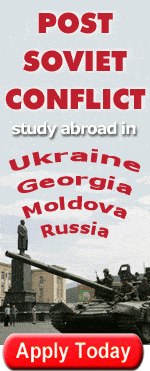
Georgia is also divided into eastern and western halves by the Likhi Range. Historically, the more western portion has been known as Colchis, Lazica, or Aphazia. This area was once a Roman province and is referred to in Greek mythology as a land of great warriors and fabulous wealth including the Golden Fleece famously sought by Jason and the Argonauts. The eastern portion, the homeland of the ethnic Georgians, has been known as Iberia or Kartlis. Once a Roman protectorate, the great kingdom that resided here saw itself connected with Alexander the Great and with the natives of Spain’s Iberian Peninsula. To the north, the high plateau of Svaneti also forms a distinct geographic region, inhabited by a people known for producing herders, fierce warriors, and bandits.
Early Georgian History

The ancient kingdoms of Colchis and Iberia.
Georgia’s two halves have often been politically separate. They first unified in the 4th century BCE, shortly after both converted to Christianity. This kingdom was an early example of the type of Christian monarchy with a hierarchal aristocracy that would come to dominate Europe in the middle ages.
However, this unified state soon broke into a number of competing principalities. Throughout classical antiquity, greater empires such as the Diadokhi, the Romans, and the Persians all attempted to extend their influence into the region.
The conflicts of the fifth and sixth centuries, however, also saw the rise of one of Georgia’s greatest national heroes: Vakhtang Gorgasali, the founder of the city of Tbilisi, now Georgia’s capital. Vakhtang was a powerful king of Iberia, and played a delicate diplomatic dance between the two great empires of the Persians and the Byzantines. Eventually exiled by the Persians, Vakhtang’s deeds were later recorded in The Life of Vakhtang Gorgasali, an epic poem and one of Georgia’s earliest literary works. It is also the first book of the Kartlis Tskhovreba, a collection of tales and chronicles which are the best historical source on classical and early medieval Georgia.
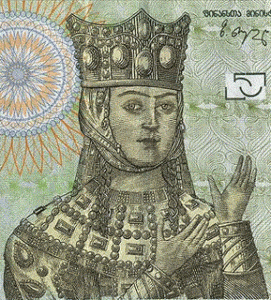
Queen Tamar the Holy as pictured on Georgia’s 50 Lari note.
With Vakhtang’s downfall, Georgia remained politically fragmented until the ninth century, when Prince Ashot I rose to the throne of Iberia, then known as Kartli. His dynasty would unite and rule Georgia for nearly a thousand years. A golden age arose during the twelfth and thirteenth centuries during the reigns of King David the Builder and then Queen Tamar, the first female ruler of Georgia. Under David the Builder, the influence of the Georgian Kingdom was extended from the Black Sea to the Caspian and south into Armenia. Queen Tamar pushed into Asia Minor and northern Persia. Rich cultural monuments were also created, such as stone cathedrals and literary works such as “The Knight in Panther’s Skin” by Shota Rustaveli, now considered Georgia’s national epic poem.
Georgia’s golden age was brought to an end soon after Tamar’s death. The city of Tbilisi was sacked by the Khwarezmians in 1226, and further invasions by the Chinggisids, Timurids, and Turkmen Confederations resulted in increasing chaos. By the mid-fifteenth century, Georgia was in a state of virtual anarchy, and found itself divided between the Ottoman Empire in the West and the Safavid Empire in the East. Rebellions occasionally occurred and a portion of Eastern Georgia succeeded in breaking free from Persian control in the late eighteenth century. It immediately sought the protection of the Russian Empire.
Georgia under the Russians and Soviets
Under the 1783 treaty of Georgievsk, Russia promised to protect Georgian autonomy, but Tsar Paul I instead annexed the land in 1800. The Russian army quickly moved into Georgia, pushing back the Persians and taking Western Persia as well and later fighting a series of wars with the Ottomans, reuniting much of the old Kingdom of Georgia within the Russian Empire.

A statue of Stalin outside the Stalin Museum in Gori, Georgia. Picture by SRAS student Paula Hunter, taken while traveling with SRAS as part of the Policy and Conflict in the Post Soviet Space program. See more of Paula’s pictures here.
With the Russian Revolution of 1917, Georgia declared independence as the Democratic Republic of Georgia. In 1920, however, the Bolsheviks invaded, re-annexing it into the Soviet Union in February, 1921. A major uprising in 1924 was firmly quelled, and Georgia was incorporated into the Transcaucasian SSR. In 1936, the Transcaucasian SSR was unincorporated and the territory of Georgia became the Georgian SSR. Interestingly, the government-in-exile representing the Democratic Republic continued to operate in France until 1953, when its prime minster died.
Despite the prominence of Joseph Stalin (born Joseph Djugashvili), Georgia did not have a favored position in the Soviet Union, and development proceeded rather slowly there.
While Georgia was not a battleground during WWII, it did contribute half a million soldiers to the Red Army and its textile and munitions factories were vital to the Soviet war effort. In an apparent effort to keep local support, Stalin allowed the Georgian Orthodox Church to become an autonomous entity in 1943. The church had been founded in the fourth century AD but usurped by the Russian Orthodox Church under the Russian empire during the nineteenth century.
The continued influence of the church is one aspect of ways that Georgians resisted “russification” and both Russian and Soviet rule. As the Soviet economy faltered and the state’s political bonds were weakened in the late 70s and 80s, an independence movement with strong human rights overtones grew in Georgia. Zviad Gamsakhurdia, a prominent intellectual and the author of several literary works and translations of world classics into Georgian, became its main leader.
In 1990, Gamsakhurdia was elected as Chairman of the Supreme Council of Georgia, the highest position in Georgia’s communist government. Shortly thereafter on April 9, 1991, Georgia declared independence from the Soviet Union and Gamsakhurdia was subsequently elected as the first independent President.
Post-Soviet Georgia: Ethnic Conflict and Russian Influence
Politically, Georgia’s post-Soviet history has been driven in large part by its uneven economic development and conflicts with major ethnic minority enclaves.
While Zviad Gamsakhurdia had been a uniting figure as a dissident, as president he tried to create a sense of Georgian nationalism through the use of slogans like “Georgia for the Georgians” and a pledge to linguistically and politically integrate autonomous, ethnic enclaves like Abkhazia and South Ossetia.
The eponymous Georgians are the majority group with approximately 70-80% of the population (although censuses have been rare and unreliable). They speak the Georgian language (known as Kartuli), part of the Kartvelian family of languages. Other languages in the Kartvelian family are Mingrelian, Laz, and Svan, which are spoken by small minorities in Georgia and are largely mutually comprehensible.
The Abkhaz people speak Abkhaz, a language loosely related to some other northern Caucasian languages. Ossetian, a language also spoken in the North Ossetia region of Russia, is an Indo-European language closely related to Persian. The Adjarans also populate a small, autonomous region and have negotiated to stay within the Georgian Republic with considerable privileges. Georgia is also home to significant minorities of Russians, Armenians, Azeris, and Greeks.

Zviad Gamsakhurdia, Georgia’s first president.
While a less contentious issue, Georgia is also a multi-confessional state, with the confessions divided largely on ethnic lines. Approximately 80% of the population is Georgian Orthodox. The Georgian Orthodox Church is an independent Eastern Orthodox Church headed by the Catholicos-Patriarch of all Georgia, a post held at present by the widely-respected and politically influential Ilia II. Muslims are a significant minority at 10% of the population. The rest are largely Armenian Christians and Russian Orthodox, although there is also a small yet very old community of Jews.
The immediate result of Gamsakhurdia’s nationalist policies was unrest amongst Georgia’s ethnic minorities and outright rebellion in South Ossetia, which led to a war that lasted from January of 1991 to June, 1992. South Ossetia ended the conflict with defacto but unrecognized independence in a peace brokered by and maintained by Russian peacekeepers.
Encouraged by the unrest, a coup led by elements of the military and parts of the old Communist elite was launched against Gamsakhurdia in December of 1991. A civil war ensued between the supporters of Gamsakhurdia and Eduard Shevardnadze, the former minister of foreign affairs of the Soviet Union and ringleader of the coup. Shevardnadze’s supporters gradually took control of the country with Russian support. Gamsakhurdia died in December of 1993, though it is unclear whether his death was a suicide or an assassination. Shevardnadze then organized a new government and in November of 1995 was elected president with a large majority.
Conditions did not improve, however. Abkhazia followed the example of South Ossetia and in July, 1992, seceded from Georgia when Shevardnadze’s military council seemed to threaten their autonomous status. Shevardnadze attempted to retake Abkhazia from 1992-3, which successfully defended its autonomy with Russian support. In addition to Abkhazia’s outright secession, Adjara also insisted on significant rights of autonomy, creating a situation that threatened to take yet another territory from the republic.
Thus, only a few years after attaining independence, Georgia had gone through a civil war and two rebellions. Nearly a third of Georgian territory was either functionally independent or from the central government, and the portion that was ruled by Tbilisi largely felt that its government was corrupt, oppressive, and ineffective.
The Georgian parliamentary elections of November 2, 2003, nevertheless, resulted in a large win for supporters of Shevardnadze. Georgians took to the streets to protest perceived voter fraud and other electoral violations in what would later be called the Rose Revolution. Protestors even stormed the parliament building, causing Shevardnadze to declare a state of emergency. On November 23, he resigned as president. The speaker of the parliament, Nino Burjanadze, briefly took over the responsibilities of President until new elections in January, 2004 brought Mikheil Saakashvili, a prominent opposition politician, into the office, mainly on an anti-corruption platform. Shevarnadze, however still lives in Tblisi, and with the current change in government, seems to be contemplating a return to politics or a concerted effort to rewrite the history of his presidency. He has publically apologized, for example, to the people of Georgia for giving up the reigns of power and allowing Saakashvilli to become president. Nino Burjanadze is now one of the major opposition figures to Saakashvilli in the Georgian government.
Georgia after the Rose Revolution: Reform and Continued Conflict
Under Saakashvili, Georgia went through a series of rapid changes. Saakashvili reformed the Georgian police and created draconian punishments for corruption. Abroad, Saakashvili quickly became a darling of the liberal West, which called him a harbinger of democracy to the post-Soviet world. Saakashvili cultivated a close relationship with President Bush. Georgia was quickly accepted into the WTO and talks began concerning NATO membership, although NATO membership has never been granted.
Domestically, Saakashvili succeeded in bringing Adjara back under the authority of the central government, but Abkhazia and South Ossetia retained their defacto independence. While corruption was remarkably reduced, some were uneasy with the harshness of Georgia’s new police force. Furthermore, while Tbilisi saw many improvements in the period, for most of the country life continued as it had before with no improvements to infrastructure or social services. Opposition to Saakashvili began to grow, resulting in extensive protests in 2007 and the governments’ using increasingly heavy-handed means to disperse them and control their leaders.
Seeking to reaffirm his legitimacy, Saakashvili called for early presidential elections to be held on January 5, 2008, Saakashvili was re-elected with 53% of the vote, a slim margin for a candidate who took 90% in his first election. Saakashvili was criticized by his opponents for closing Imedi, a prominent opposition TV station, and also for the early elections, which opponents say gave the opposition little time to organize against him.
On August 7, 2008 Saakashvili launched a military operation to reclaim South Ossetia. This went against the Russian-brokered peace agreement and resulted in the deaths of Russian peacekeepers. Russia reacted strongly, sending in troops, tanks, and airstrikes that cut Georgia in two, came within 50 kilometers of Tbilisi, and virtually destroyed Georgia’s military. Russia officially recognized Abkhazia and South Ossetia as independent nations, sealing agreements to maintain a local military presence there and thus ensuring that any further military action by Georgia would be met with a similar response. Georgia broke off diplomatic relations with Russia after this, resulting in closed borders and increased hostility with Georgia’s largest neighbor and formerly biggest trading partner.
Meanwhile, opposition protests grew. The OSCE reported that parliamentary elections were increasingly marked by electoral fraud and suppression of the media, while videos surfaced in 2012 showing the abuse of convicts by prison guards. On October 1, 2012, an opposition coalition led by Bidzina Ivanishvili, Georgia’s richest man and previously considered a political underdog, defeated Saakashvili’s party and took a majority in the parliament. Ivanishvili has pledged to work with Saakashvili, but has also begun to purge Saakashvili supporters from the government, even imprisoning many under charges of corruption and abuse of power in what may be a campaign of retribution. A secretive figure in private life, Ivanishvili is a businessman who amassed a fortune from companies operating in the Russian Federation. Many feel that Ivanishvili will reorient Georgia’s politics towards Russia and revive the trade lost under Saakashvilli.
Saakashvili’s second and final term will end in 2013. He and his party have no clear successor; Saakashvili may have intended to become prime minister himself and continue ruling Georgia from that position. Now it seems more plausible that Ivanishvili may well seek to move from prime minister to the higher office.
Modern Georgia: Life on the Ground
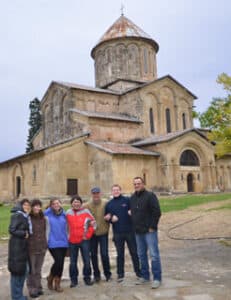
SRAS students travel Georgia as part of the Policy and Conflict in the Post Soviet Space program. Here, they are pictured outside the historic Gelati Monastery, about 140 miles northwest of Tbilisi.
Today, in part due to the Soviet’s tendency to concentrate development on a central urban center, Georgia’s capital of Tbilisi dominates the country. Its population of 1.5 million represents about 30% of Georgia’s total population of 4.7 million. Tbilisi is the country’s most economically developed city and the most politically powerful. Kutaisi is Georgia’s second largest city, a depressed former industrial center with just under 200,000 residents. Georgia’s parliament was moved to this city in 2010 in an attempt to encourage development there and to further breakup government functions and thus curb corruption. Also politically important is Batumi, a coastal city of about 120,000 and the capital of Adjara, a small autonomous region in Georgia and the home of the Adjarans, an ethnic minority. Batumi is now the home of Georgia’s Constitutional Court, for much the same political and economic reasons as Kutaisi received the new parliament building.
Other important cities include Poti, a small city on Georgia’s Black Sea coast and the country’s largest and main link to Europe. Gori is a small but strategic town in the center of the country which acts as the main link between eastern and western Georgia. Both Poti and Gori were targeted by Russian attacks during the 2008 war because of their strategic significance. Mtskheta, the ancient capital of the Georgian Kingdom, is now a suburb Tblisi. With just 20,000 residents, the city is most remarkable for its ancient streets and surrounding archeological landmarks.
Auto manufacturing is now the largest single export industry in Georgia, thanks in large part to foreign investment brought in under Saakashvili. However, as Georgians were once known to the Romans primarily as farmers, today agriculture and the production of food and beverages remain an important part of the Georgian economy and culture as well. Agriculture accounts for 7% of Georgia’s GDP, but employs 55% of its labor force, the majority of whom are involved only in subsistence agriculture. This is a sign of inadequate development in an economy and has been the source of some social tension in Georgia.
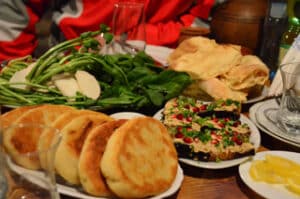
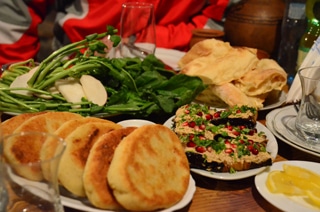
More profitable are the production of citrus fruits, tea, nuts, cheese, and grapes. The latter is often then used to produce wine, a craft that has been present in Georgia for some 8000 years according to archeological evidence and in which Georgia takes immense pride. Thus, when Russia banned Georgian wines as unsafe in Russia, it was a psychological blow to Georgia as well as economic: wine is one of Georgia’s largest exports and Russia formerly bought up to 80% of that export.
Georgia’s mountains help provide many more jobs. Gold, iron, magnesium, and copper are all mined. Rivers flowing through mountainous terrain have provided enough hydropower development that Georgia now exports electricity. Hundreds of thousands of tourists per year come to see the beautiful vistas provided by the Caucasus Mountains and the neighboring Black Sea as well as to partake of Georgia’s reputation for hospitality and great food. Georgian food has strong Middle Eastern influences meaning that, in contrast to much of the food common in the former Soviet Union, Georgia’s cuisine is heavy on herbs, nuts, and flavor.
Overall, the Republic of Georgia is a relatively new state with significant internal divisions that has seen much conflict in its brief history. However, of the post-Soviet states Georgia has one of the most promising democracies, and the relatively smooth transfer of power following the recent parliamentary election gives hope that Georgia will overcome its difficulties and become a bastion of stability and democracy in the Caucasus.




